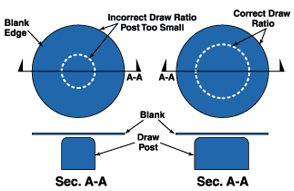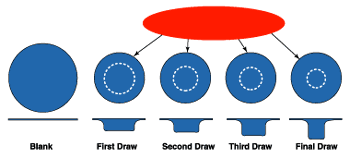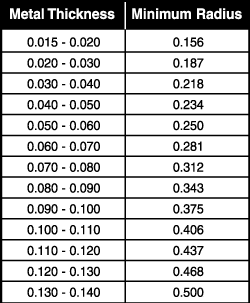Contributing Writer
- FMA
- The Fabricator
- FABTECH
- Canadian Metalworking
Categories
- Additive Manufacturing
- Aluminum Welding
- Arc Welding
- Assembly and Joining
- Automation and Robotics
- Bending and Forming
- Consumables
- Cutting and Weld Prep
- Electric Vehicles
- En Español
- Finishing
- Hydroforming
- Laser Cutting
- Laser Welding
- Machining
- Manufacturing Software
- Materials Handling
- Metals/Materials
- Oxyfuel Cutting
- Plasma Cutting
- Power Tools
- Punching and Other Holemaking
- Roll Forming
- Safety
- Sawing
- Shearing
- Shop Management
- Testing and Measuring
- Tube and Pipe Fabrication
- Tube and Pipe Production
- Waterjet Cutting
Industry Directory
Webcasts
Podcasts
FAB 40
Advertise
Subscribe
Account Login
Search
Deep drawing: Key design principles & tips for successful draws
- By Art Hedrick
- Updated January 20, 2023
- May 30, 2001
- Article
- Bending and Forming

Figure 1: In the illustration of incorrect draw ratio (L), the too-small post would cause metal to thin to the point of failure, while the correct draw ratio (R) will result in a successfully deep drawn part.
Successful deep drawing depends on many factors. Ignoring even one of them during die design and build can prove disastrous. However, regardless of the many factors involved, the most important element to a successful deep drawing operation is initiating metal flow. The following are key elements affecting metal flow, and each of them should be considered when designing, building, or troubleshooting deep drawing stamping dies:
Key Elements in Deep Drawing
- Material type
- Material thickness
- N and R values
- Blank size and shape
- Part geometry
- Press speed (ram speed)
- Draw radii
- Draw ratio
- Die surface finish
- Die temperature
- Lubricant
- Draw bead height and shape
- Binder pressure
- Binder deflection
- Standoff height
Because thicker materials are stiffer, they hold together better during deep drawing. Thicker materials also have more volume, so they can stretch longer distances.
The N value, also called the work hardening exponent, describes the ability of a steel to stretch. The R value—the plastic strain ratio—refers to the ability of a material to flow or draw. Blank sizes and shapes that are too large can restrict metal flow, and the geometry of parts affects the ability of metal to flow. Press speeds must allow time for materials to flow.
Die surface finishes and lubricants are important because they can reduce the coefficient of friction, allowing materials to slide through tools more easily. Die temperatures can affect the viscosity of lubricants.
As a controller of metal flow, draw bead height and shape can cause materials to bend and unbend to create restrictive forces going into a tool. Increasing binder pressure exerts more force on a material, creating more restraint on material going into the tool.
The remaining key elements affecting metal flow are examined in more detail in the remainder of this article. To illustrate the principles of metal flow, this article examines two basic draw shapes, round and square. All deformation modes that occur in any given part shape are present in one of these common shapes.
The draw ratio is among the most important elements to be considered when attempting to deep draw a round cup. The draw ratio is the relationship between the size of the draw post and the size of the blank. The draw ratio must fall within acceptable limits to allow metal to flow.
During forming, a blank is forced into circumferential compression, which creates a resistance to flow. If the resistance is too great, the cup fractures. If the post is too small or too far from the blank edge, the metal stretches and thins to the point of failure. If the post is the appropriate distance from the blank edge, and the die entry radius is acceptable, the metal can flow freely, progressively thickening as it enters the die cavity (see Figure 1).
When a very tall small-diameter part is being processed, draw reductions likely will be necessary (see Figure 2). A draw reduction is a process in which a part is first formed within acceptable draw ratio limits and then is progressively reduced or reshaped to a desired shape and profile.
The most important factor to remember when performing draw reductions is that all of the material necessary to make the final part shape must be present in the first draw. Figure 3 is a reduction chart for the first, second, and third draws with draw-quality steel. Reduction percentages are based on metal thickness and type.
To determine the post diameter and height of the first draw, the total surface area of the finished part must be calculated. (If the part is to be trimmed, allow additional material during this calculation.) The calculated surface area is then converted into a flat blank diameter.
The primary step in calculating the first draw post diameter is determining the blank diameter. Multiplying the blank diameter by the percentage given in the chart, and then subtracting the result from the original blank diameter, yields the diameter of the first draw post. It is important to remember that all dimensions are taken through the centerline of the material. The height of the first draw is an area calculation directly related to the amount of material necessary to make the finished part.
Die Entry Radii in Deep Drawing
Other important factors for successful deep drawing are the size, accuracy, and surface finish of the die entry radius. Decisions regarding the die entry radius should be based on material type and thickness.
If a die entry radius is too small, material will not flow easily, resulting in stretching and, most likely, fracturing of the cup. If a die entry radius is too large, particularly when deep drawing thin-gauge stock, material begins to wrinkle after it leaves the pinch point between the draw ring surface and the binder. If wrinkling is severe, it may restrict flow when the material is pulled through the die entry radius.
Figure 4 provides general guidelines for die entry radii for round draws of draw-quality steel ranging in diameters from about 1.5 to 15 inches.
The die entry must be produced accurately in a fashion that makes it true and complete. It should be hook-free and polished in the direction of flow. High-wear tool steel should be used for die entry radii.
Deep Drawing Binder Pressure
Sufficient binder pressure must be present to control metal flow. If binder pressure is inadequate, the material wrinkles during compression. The wrinkles then cause the binder to further separate from the draw ring surface, and control of the material will be lost. Wrinkles will also be forced to unwrinkle when the material is squeezed between the post and the cavity walls. This can pull metal on the top of the cup and result in fracture.
The problem of too much binder pressure can be overcome by using standoffs. Standoffs maintain a given space between the draw ring surface and the binder, and they should be set at 110 percent of the metal thickness to allow for compressive thickening. If the standoff gap is too small, the material will be pinched tightly between the draw ring and the binder surface, reducing its ability to flow freely. If the standoff gap is too large, the material will wrinkle during circumferential compression.
The recommended binder pressure for round draws of low-carbon draw-quality steel is 600 pounds per lineal inch around the post (draw post diameter x 3.141). For high-strength, low-alloy, and stainless steels, 1,800 pounds of pressure per lineal inch should be used.
Other guidelines to remember when the processing draw reductions are:
- Design open-ended draw cavities for draw depth adjustment.
- Once the proper draw ratio is achieved, metal will flow and the part can be drawn partially or completely off the binder.
- After the first draw, the blank diameter should not change. (See Figure 3).
Square Draws
Square draws are similar to round draws because they contain four 90-degree profile radii. Because of the radial corner profile, material flowing toward the corners is forced into compression. The straight sections of the square are simply being bent and unbent. Considerably less flow restriction takes place in the straight walls of a square draw than in the corners (see Figure 5).
Increasing the profile radius of the draw greatly increases the ability to draw deeper in a single operation (see Figure 6) because a larger-profile radius reduces compression. Too much compression in a corner restricts metal flow, resulting in fracture.
Increasing the profile radius and reducing the blank size reduce forming severity. Mitering the corners of the blank also can help to reduce compression.
To help balance metal flow conditions during square draws involving heavy metals, it may be necessary to draw spot the corner areas of the binder or draw ring face with respect to the increasing material thickness. This process allows metal to thicken in corners without being pinched excessively between the draw ring and the binder.
If a proper draw spot is achieved, blank holding force is evenly distributed through the perimeter of the drawn shell. When thin metal is used, draw spotting the corners may cause undesirable wrinkling in the relieved areas. This results primarily from a lack of control of the metal flow and the inability of thin stock to resist wrinkling.
If the square drawn shell is too tall to be drawn in a single operation, it must undergo a draw reduction. As with round draws, all material necessary to make the final part must be present in the first draw. Draw reductions for square shells are achieved by increasing the profile radius to acceptable compression limits and increasing the width and length to obtain the necessary surface area of the finished part.
Other guidelines to follow when drawing square shells include:
- Use the minimum blank size required to make the part.
- Use standoffs to control metal flow, not binder pressure.
- To redraw a square shell, increase the width, length, and profile radius of the first draw to contain the necessary surface area of the final part geometry.
Successful deep drawing is a combination of many important factors. This article highlights only the most frequently violated design and build principles. Although designing and building deep draw dies is fast becoming a science, the fundamental metal flow principles should never be ignored, for they are the foundations of a successful deep drawing operation.
About the Author

Art Hedrick
10855 Simpson Drive West Private
Greenville, MI 48838
616-894-6855
Related Companies
subscribe now

The Fabricator is North America's leading magazine for the metal forming and fabricating industry. The magazine delivers the news, technical articles, and case histories that enable fabricators to do their jobs more efficiently. The Fabricator has served the industry since 1970.
start your free subscription- Stay connected from anywhere

Easily access valuable industry resources now with full access to the digital edition of The Fabricator.

Easily access valuable industry resources now with full access to the digital edition of The Welder.

Easily access valuable industry resources now with full access to the digital edition of The Tube and Pipe Journal.
- Podcasting
- Podcast:
- The Fabricator Podcast
- Published:
- 04/16/2024
- Running Time:
- 63:29
In this episode of The Fabricator Podcast, Caleb Chamberlain, co-founder and CEO of OSH Cut, discusses his company’s...
- Industry Events
16th Annual Safety Conference
- April 30 - May 1, 2024
- Elgin,
Pipe and Tube Conference
- May 21 - 22, 2024
- Omaha, NE
World-Class Roll Forming Workshop
- June 5 - 6, 2024
- Louisville, KY
Advanced Laser Application Workshop
- June 25 - 27, 2024
- Novi, MI


































